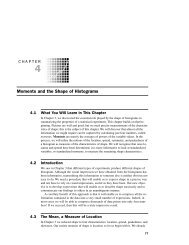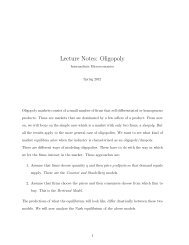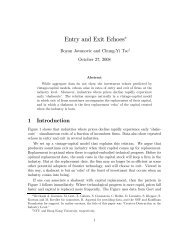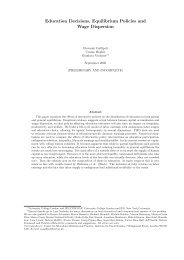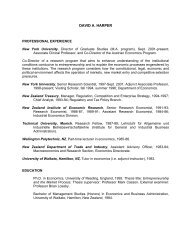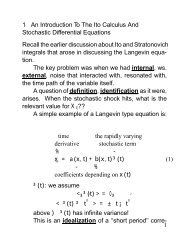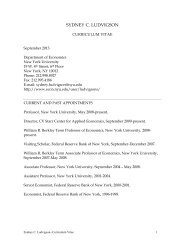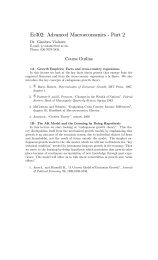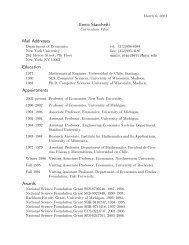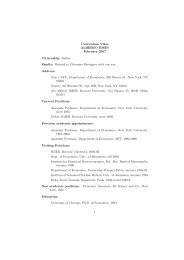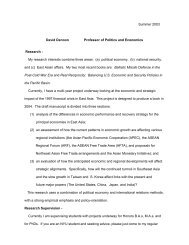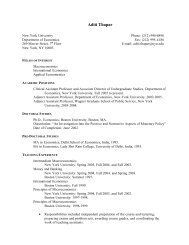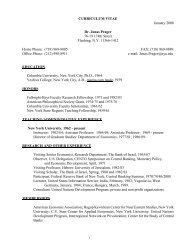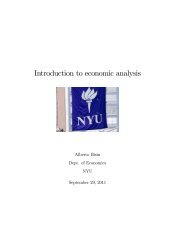On Spatial Processes and Asymptotic Inference under Near$Epoch ...
On Spatial Processes and Asymptotic Inference under Near$Epoch ...
On Spatial Processes and Asymptotic Inference under Near$Epoch ...
Create successful ePaper yourself
Turn your PDF publications into a flip-book with our unique Google optimized e-Paper software.
<strong>and</strong> that for 2 n = V ar( P<br />
i2Dn Vi;n) = 0 n we have<br />
inf<br />
n jDnj 1 2 n = inf<br />
n jDnj 1 0 n inf<br />
n jDnj 1 min( n) > 0:<br />
From this we see that <strong>under</strong> the maintained assumptions Vi;n satis…es all assumptions<br />
P<br />
of the CLT for scalar-valued r<strong>and</strong>om …elds (Theorem 1) <strong>and</strong>, there-<br />
1 fore, n Vi;n ) N(0; 1) as claimed.<br />
Next de…ne Xi;n = Vi;n, then by analogous arguments as above<br />
jXi;nj jYi;nj :<br />
From the maintained uniform L2+ integrability of jYi;nj it then follows that<br />
kXk 2+ kY k 2+ , which shows that the 2+ moments of Xi;n can be bounded<br />
by a constant that does not depend on . Consequently if follows from the last<br />
inequality in the proof of part (a) of Lemma B.3 that<br />
V ar( X<br />
i2Dn<br />
Xi;n) = 0 n CjDnj<br />
where C < 1 does not depend on n <strong>and</strong> . Hence<br />
sup<br />
n<br />
jDnj 1 max( n) = sup jDnj<br />
n<br />
1 sup<br />
j j=1<br />
0 n C < 1.<br />
This proves the second claim of the lemma. Q.E.D.<br />
Proof of Theorem 2: To prove the theorem, it su¢ ces to show that jDnj 1 P<br />
0. First we show that for each given s > 0, the conditional mean V s<br />
i;n =<br />
E(Yi;njFi;n(s)) satis…es the assumptions of the L1-norm LLN of Jenish <strong>and</strong><br />
Prucha (2009, Theorem 3). Using the Jensen <strong>and</strong> Lyapunov inequalities gives<br />
for all s > 0, i 2 Dn; n 1:<br />
E V s p<br />
i;n EfE(jYi;nj p jFi;n(s))g sup E jYi;nj<br />
n;i2Dn<br />
p < 1:<br />
So, V s<br />
i;n is uniformly Lp-bounded for p > 1 <strong>and</strong> hence uniformly integrable.<br />
For each …xed s; V s<br />
i;n is a measurable function of f"j;n; j 2 Tn : (i; j) sg.<br />
Observe that <strong>under</strong> Assumption 1 there exists a …nite constant C such that the<br />
cardinality of the set fj 2 Tn : (i; j) sg is bounded by Csd ; compare Lemma<br />
A.1 in Jenish <strong>and</strong> Prucha (2009). Hence,<br />
V s(1; 1; r)<br />
<strong>and</strong> thus in light of Assumption 6(b)<br />
1X<br />
r=1<br />
r d 1 V s(1; 1; r)<br />
X2s<br />
r=1<br />
1; r 2s<br />
Cs d ; Cs d ; r 2s ; r > 2s<br />
r d 1 + '(Cs d ; Cs d )<br />
30<br />
1X<br />
(r + 2s) d 1 b(r) < 1:<br />
r=1<br />
!<br />
i2Dn (Yi;n EYi;n) L1



